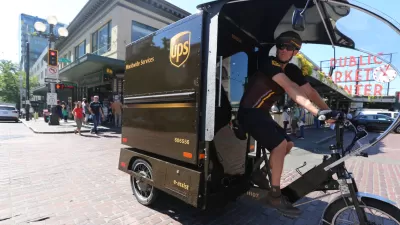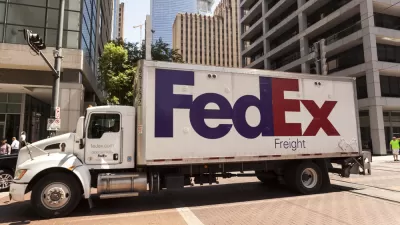How cities can minimize the impact of delivery vehicles on air quality and congestion through effective curb management and zero-emission delivery zones.

As urban delivery services become more common for a wider variety of goods and services, cities are looking at ways to cut down on the emissions and congestion caused by delivery vehicles. Writing in The City Fix, Hamilton Steimer and Vishant Kothari outline the results of a paper from the World Resources Institute (WRI) that assesses efforts to create ‘zero-emission delivery’ zones in the United States and the Netherlands.
As the article explains, “Zero-emission delivery zones are areas in which only zero-emission vehicles have unrestricted access, with fossil fuel vehicles either prohibited from entry or required to pay a fee for access.” The zones can take a variety of forms, from voluntary zones to localized pick-up locations and curbside spaces reserved for ZEVs.
The authors provide detail on the city of Los Angeles’ zero-emission commercial loading zones, which regulate curbside management in five dense areas with high demand for commercial loading and high levels of air pollution. “If expanded, zero-emission loading zones could discourage fossil fuel vehicle use in specific areas, incentivize a shift to zero-emission delivery throughout Los Angeles, and reduce residents’ exposure to air pollutants like particulate matter and nitrous oxides.”
The paper also provides five recommendations for developing and implementing zero-emission delivery zones successfully. As the authors caution, “Without proper design and implementation, zero-emission delivery zones and supportive policies could exacerbate existing inequities, such as diverting polluting freight traffic through neighborhoods outside the zone or failing to supply small businesses in the zone with the necessary financial support to purchase ZEVs.”
FULL STORY: Zero-Emission Delivery Zones: A New Way to Cut Traffic, Air Pollution and Greenhouse Gases

Trump Administration Could Effectively End Housing Voucher Program
Federal officials are eyeing major cuts to the Section 8 program that helps millions of low-income households pay rent.

Planetizen Federal Action Tracker
A weekly monitor of how Trump’s orders and actions are impacting planners and planning in America.

Ken Jennings Launches Transit Web Series
The Jeopardy champ wants you to ride public transit.

California Invests Additional $5M in Electric School Buses
The state wants to electrify all of its school bus fleets by 2035.

Austin Launches $2M Homelessness Prevention Fund
A new grant program from the city’s Homeless Strategy Office will fund rental assistance and supportive services.

Alabama School Forestry Initiative Brings Trees to Schoolyards
Trees can improve physical and mental health for students and commnity members.
Urban Design for Planners 1: Software Tools
This six-course series explores essential urban design concepts using open source software and equips planners with the tools they need to participate fully in the urban design process.
Planning for Universal Design
Learn the tools for implementing Universal Design in planning regulations.
Ada County Highway District
Clanton & Associates, Inc.
Jessamine County Fiscal Court
Institute for Housing and Urban Development Studies (IHS)
City of Grandview
Harvard GSD Executive Education
Toledo-Lucas County Plan Commissions
Salt Lake City
NYU Wagner Graduate School of Public Service




























